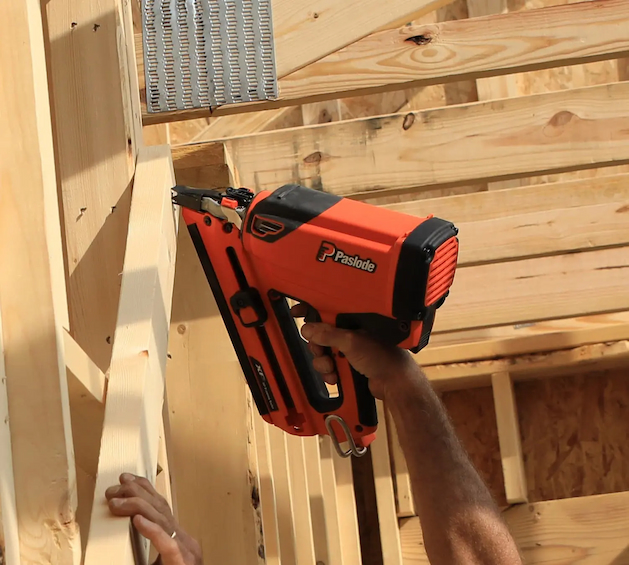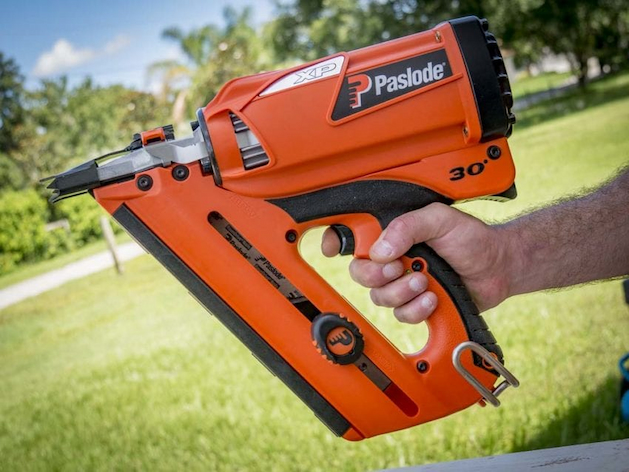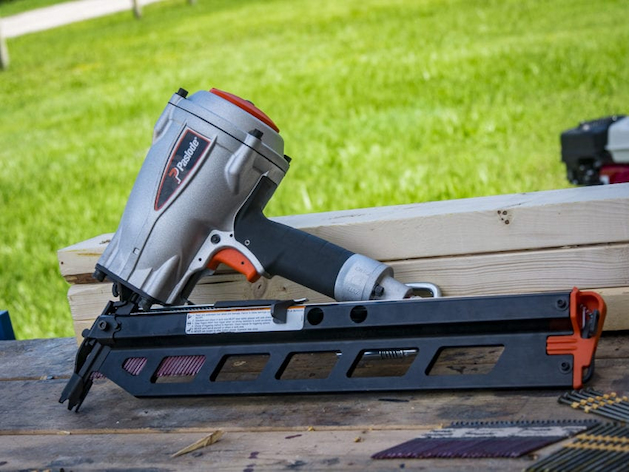Cordless nail guns are irreplaceable tools on modern building sites, and they’ve quite possibly been the single greatest contributor to how much faster the beginning and finishing stages of many construction projects are now being completed.
While an experienced framer or tradie might be able to drive in a hundred nails an hour, even an apprentice with a cordless nail gun is capable of driving in well over a thousand. And for contractors and customers alike, that translates to significant savings in cost, time, and energy.
Cordless nailers have been game changers, but just being cordless isn’t enough for a nailer to be efficient: it also needs to be as powerful, and as light as possible. Fortunately, the pioneer of cordless nailers understands what these characteristics mean, and they’re pushing the envelope on nail gun innovation harder than ever.
Paslode Gas Fuel Cell Technology Gives Your Nailer the Advantage

source: paslode.com/
Let’s be honest: although a cordless nailer can go anywhere on a job site, no one wants to lug a husky 4.5kg nailer around all day. Bulky batteries attached to even bulkier devices are anything but efficient, which is why fuel-powered Paslode cordless nail guns are designed to remove that obstacle entirely.
Not only does Paslode have the distinction of introducing the first pneumatic nailer in 1959, but they were also the first to see the benefit of doing away with the external air supply altogether. It took them even less time, however, to recognize the need to think beyond simply making batteries bigger, and to focus on making their nailers more efficient. The result is the patented gas fuel cell technology that they’ve been using on their nail guns since 1986.
Ultimately, it’s no surprise that job sites are where the benefits of gas fuel technology are seen in real-time over big-battery tools, including:
- A marked reduction in the initial investment, and recurring costs of replacing pricey cordless batteries;
- Less time is spent charging and recharging batteries that other personnel may also be using; and,
- A cordless tool that weighs less than half of what its big battery-powered counterpart weighs.
In short, fuel-powered nailer users are finding themselves spending less money, and committing less time and energy to work with gas fuel cell technology than they ever have with standard cordless nailers. Let’s take a closer look at precisely how this extraordinary technology works, and just what it means for productivity when compared to other cordless nailers.
Fuel-Powered Efficiency That You Can See on Your Bottom End

source: protoolreviews.com
Although fuel cell technology sounds exotic, the process that’s been developed and patented by Paslode power tools couldn’t be simpler.
When the tip of the nailer is placed against a piece of lumber, a measured amount of fuel (a propellant mixture of butylene and propylene) is released from a twin-layered fuel cell into the nailer’s combustion chamber, and is mixed with air by the tool’s internal fan. When the nailer’s trigger is pulled, the tool’s battery generates a spark in the chamber, forcing a bladed piston assembly to shear a nail away from the nail strip, and to drive it into the lumber by the force of the propellant.
Ideally, a Paslode nailer with fuel cell technology functions on the same principle as a 2-stroke engine; but with a total weight of only 2kg, it’s a powerful design concept which, depending on the model, allows the user to drive in:
- Between 2 – 3 3¼” (82mm in length) nails per second;
- Up to 1200 nails with each disposable fuel cell; and,
- As many as 9000 nails on every full battery recharge.
Paslode fuel cell technology allows anyone using one of their lightweight cordless framers, finishers or fixing tools to better manage their costs and productivity. There’s never a need to buy fuel cells unless you need them, and routine care and maintenance of the nailer’s other accessories help you to get the most reliable use possible from them.
Long-Life Batteries Let You Get the Most From Your Fuel-Powered Nailer

source: protoolreviews.com/
While the biggest talking point for Paslode cordless nailers are their long-lasting fuel cells, the rechargeable lithium-ion battery that ignites the air and fuel mixture is no less an integral part of its design. At 0.15kg, ultra-lightweight 7.4V lithium-ion batteries are the standard power source for Paslode’s current generation of fuel-powered cordless, and they boast:
- A 50% longer battery life than their predecessors;
- A 1 hour charge time that holds a charge up to 5 times longer; and,
- A 2-minute quick battery charge for up to 200 nails.
These batteries also serve as the nailer’s interim OFF / ON switch by preventing accidental fastener discharges when they’re not fully engaged. Paslode even makes new, higher amperage nickel metal hydride (NiMH) 6V batteries available to help breathe greater flexibility into their older fuel-powered nailer models.
With the advantages that Paslode tools have in improved power and weight ratings, the only aspect left to optimize is the fasteners themselves. Fastener gauges may all be the same but their quality isn’t, and that’s why high-quality Paslode fasteners are the only ones you want to trust with a fuel-powered nailer.
Paslode Nails Help You Fuel-Powered Nailer Perform at Its Best
Paslode makes a full range of fastener sizes, especially for their fuel-powered nailers. They’re designed to reduce the potential for jams and misfires that may occur with lesser-quality fasteners, and include the most common sizes for most framing and finishing jobs.
- 15-gauge. 1¼” – 2½” in length, with a head diameter of 3/16″ and a shank diameter of .0720”.
- 16-gauge. 1¼” – 2½” in length, with a head diameter of 3/16″ and a shank diameter of .0625”.
- 18-gauge. 5/8” – 2” in length, a slightly smaller head diameter, and a shank diameter of .0475”.
These hot-dip galvanized fasteners are paper tape collated, and are ASTM-standardized for exterior applications and treated lumber. They’re equally effective, however, for both interior and exterior trim, as well as window and door casings.
Paslode fasteners longer than 3” in length also use specialized tip coatings that act as both a lubricant to help drive the nail into the lumber, and as a fixative to help hold it in place once it’s driven in. Tip coatings can be either black or red, with black being slightly more suitable for earlier fuel-powered Paslode nail gun models that don’t have the same force as newer models. Tip-coated nails are also commonly sold in fastener/gas fuel combo packs that help to take the guesswork out of having the correct amount of consumables on hand.
The Final Word
Make no mistake: as the number of housing starts continues to grow in Australia, the need to get them framed and finished quicker has also grown. If you’re in the construction business, you already know that the pressure to keep costs down while keeping productivity up is at an all-time high; and at the end of the day, it means that your tools have to perform just as well as you do.
With fuel-powered Paslode cordless nail guns, not only can you frame and finish quicker, you can do it at a cost level that’ll let you instantly see the benefit of your bottom line. They’re the leading edge of nail gun innovation, and they can count on them to make your job more efficient.


